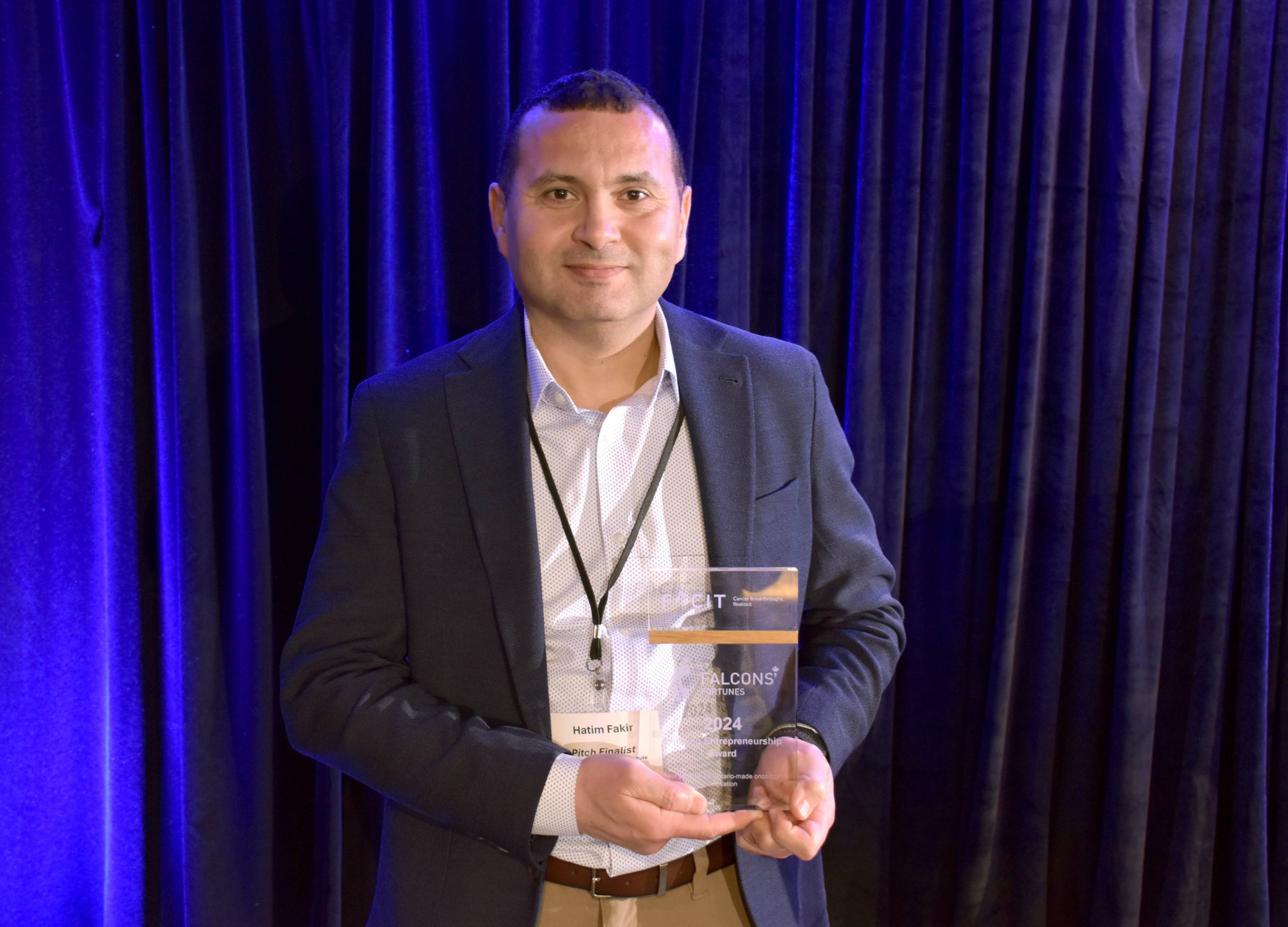Dr. Hatim Fakir of London Health Sciences Centre won the 2024 pitch competition for his RadioSphere technology.
As a Medical Physicist, Dr. Hatim Fakir has seen first-hand how difficult radiosurgery can be for patients with brain tumours.
Radiosurgery is a specialized form of radiation therapy that uses precise, highly focused radiation beams to destroy tumours. It’s called “radiosurgery” because it achieves clinical results similar to surgery but without the need for incisions. But the intense radiation used to kill cancer cells can also harm nearby healthy tissue, which is especially risky in the brain and can result in severe side effects such as radiation necrosis and neurological deficits.
Though there are multiple technologies that aim to make radiosurgery safer and more precise, they aren’t effective at treating patients with complex diseases, such as having multiple tumours scattered in different parts of the brain. And today’s procedures often involve long, uncomfortable treatment session.
“Patients are often not feeling well, and they have to lay immobilized in rigid positions for a very long time,” says Fakir, who is based at Verspeeten Family Cancer Centre at London Health Sciences Centre. “I wanted to find a way to make treatments more effective, faster and more comfortable for patients.”
Fakir came up with a potential solution – a new ‘radiosurgery’ technology called the RadioSphere. With a unique, adaptable design, Fakir says the RadioSphere can target tumours of all different sizes, shapes and locations in less time than existing technologies.
He pitched his concept at FACIT’s 2024 Falcons’ Fortunes pitch competition, alongside five other teams of Ontario innovators, and was selected by the panel of judges as this year’s winner.
He will receive the $100,000 Ernsting Entrepreneurship Award, as well as ongoing guidance from FACIT, to help commercialize his made-in-Ontario innovation and bring it to the patients who need it. FACIT’s Prospects Oncology Fund sponsors the award, which is a critical source of pre-seed capital in the province for early-stage, proof-of-concept projects with commercial potential.
OICR News recently asked Fakir about the story behind his innovation, and what’s next for the RadioSphere.
How did the idea for the RadioSphere come about?
As a medical physicist, I am deeply involved in planning and delivering radiosurgery treatments. I have seen the challenges that patients endure during lengthy and demanding treatment sessions, and I recognize the significant staffing and technological resources this technique demands.
While there are several excellent radiotherapy technologies out there that work well in certain situations, none of them were designed for the complex challenges we’re facing today. We regularly see patients with multiple tumours – some big, some small. Offering them optimal and safe treatments that enhance their chances of controlling the disease while maintaining a good quality of life can be extremely complex.
I wanted to design something more flexible that addresses modern radiosurgery requirements and makes treatments quicker and more comfortable for patients. I initially discussed the idea with Dr. Glenn Bauman (radiation oncologist) and Dr. Jerry Battista (medical physicist), who not only validated the need and the machine concept but also played a crucial role in kickstarting the project.
What makes the RadioSphere unique?
The RadioSphere will allow treating brain tumours of different shapes, sizes and locations with minimal risk of damage to surrounding tissue and therefore minimal risk of side effects. It will also reduce the time of treatment significantly.
What’s also unique is that the RadioSphere can potentially treat other parts of the body – not just the brain. That was important to me because that versatility could help radiotherapy centres become more efficient across a wider range of tumour situations.
What are the next steps for this work?
Our next step is to validate the system design. We’ve confirmed there is a clear clinical need, and now we need to run simulations and design experiments to see how it works in practice. We’re hoping to connect with other healthcare organizations across Ontario who do radiosurgery as part of that validation process.
Ultimately, we want to advance RadioSphere as an Ontario-born and Ontario-led innovation in radiosurgery.
What do you hope this technology could do for patients?
My goal is to provide the technical support that enables clinicians to offer patients the most optimal, safe, and state-of-the-art treatments. These treatments should be more tolerable, more effective, and enhance the overall patient experience, ultimately improving their quality of life.
I also hope that RadioSphere can improve access to radiosurgery. Since it can treat various types of tumours in the brain and other parts of the body, it could be more cost-effective for hospitals. This could enable more patients across Ontario and globally to access precision radiosurgery.
How was the experience of pitching at Falcons’ Fortunes, and how will this award help you and your work with the RadioSphere?
Participating in Falcons’ Fortunes was an invaluable learning experience that seamlessly integrated clinical practice and research with entrepreneurship and commercialization strategy. Preparing and delivering our pitch sharpened our focus on the translational aspects of our work and the process of turning our vision into a tangible product to benefit patients. FACIT’s support during this phase was indispensable, making the effort truly worthwhile through the knowledge we gained.
Falcons’ Fortunes offered a rich environment for networking and new growth opportunities. It provided essential funding to kickstart the project at a critical early stage. It also helped validate the vision behind our product.

